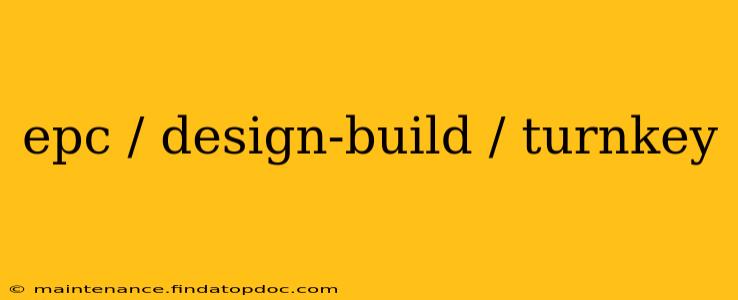The engineering, procurement, and construction (EPC), design-build, and turnkey project delivery methods are often used interchangeably, but they have distinct characteristics. Understanding their nuances is crucial for selecting the right approach for your project, whether it's a large-scale industrial plant or a smaller commercial building. This comprehensive guide will clarify the differences, highlight their benefits, and help you determine which method best suits your needs.
What is EPC (Engineering, Procurement, and Construction)?
EPC is a project delivery method where a single contractor assumes responsibility for all aspects of a project, from engineering and design to procurement of materials and construction. This "one-stop shop" approach streamlines the process, centralizing accountability and simplifying communication. The EPC contractor manages the entire project lifecycle, reducing potential conflicts and delays that can arise with multiple contractors. This method is particularly well-suited for complex projects requiring specialized engineering and procurement expertise.
Benefits of EPC:
- Simplified Project Management: A single point of contact simplifies communication and reduces potential conflicts between different contractors.
- Reduced Risk: The EPC contractor assumes responsibility for the overall project success, mitigating risk for the client.
- Faster Completion: Streamlined processes and centralized management often lead to faster project completion.
- Cost Certainty: While not always guaranteed, a fixed-price EPC contract can provide a higher degree of cost certainty compared to other methods.
What is Design-Build?
Design-build is a project delivery method where the design and construction phases are integrated into a single contract. A single entity—usually a joint venture of a designer and a constructor—is responsible for both the design and the construction of the project. This integrated approach encourages collaboration and facilitates early problem-solving, potentially leading to cost and time savings.
Benefits of Design-Build:
- Faster Project Delivery: The overlapping design and construction phases can significantly shorten the overall project timeline.
- Improved Communication and Collaboration: The single entity fosters better communication and coordination between the design and construction teams.
- Increased Innovation: Integrated teams can explore innovative design solutions and construction techniques that might not be considered in traditional methods.
- Reduced Risk: A single point of responsibility simplifies risk management.
What is Turnkey?
Turnkey projects represent the ultimate in streamlined project delivery. The contractor handles every aspect of the project, from initial conceptualization and design to final completion and handover. The client receives a fully operational facility or system—ready to "turn the key" and begin operation—without involvement in the day-to-day management of the construction process. This approach is often used for complex and specialized projects requiring extensive expertise.
Benefits of Turnkey:
- Minimal Client Involvement: The client's role is primarily limited to defining project requirements and approving final deliverables.
- Reduced Management Overhead: The contractor handles all aspects of the project, freeing up the client's resources.
- Guaranteed Performance: Often includes performance guarantees ensuring the facility meets specified operational criteria.
- Simplified Procurement: The contractor manages all procurement aspects, simplifying the process for the client.
EPC vs. Design-Build vs. Turnkey: Key Differences
While there's overlap between these methods, key distinctions exist:
| Feature | EPC | Design-Build | Turnkey |
|---|---|---|---|
| Scope | Engineering, Procurement, Construction | Design and Construction | Entire project lifecycle, including design |
| Responsibility | Single contractor | Single entity (designer & constructor) | Single contractor |
| Client Involvement | Moderate | Moderate to high | Minimal |
| Best Suited For | Complex projects, specialized engineering | Projects requiring integrated design & construction | Complex, specialized projects needing minimal client oversight |
Which Method is Right for You?
The best project delivery method depends on several factors, including project complexity, budget, schedule, and the client's level of involvement. Consider these points when making your decision:
- Project Complexity: Complex projects often benefit from the streamlined approach of EPC or Turnkey.
- Budget: Fixed-price EPC contracts can offer cost certainty, while design-build can offer flexibility.
- Timeline: Design-build and EPC can potentially accelerate project completion.
- Client Expertise: Clients with limited construction expertise may prefer a Turnkey approach.
By carefully evaluating your specific needs and circumstances, you can choose the project delivery method that optimizes efficiency, minimizes risk, and maximizes the success of your project. Consulting with experienced project managers and contractors is highly recommended to ensure the best fit for your individual project.
